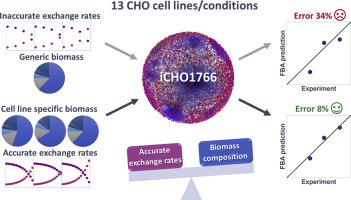Metabolic Engineering ( IF 6.8 ) Pub Date : 2020-06-30 , DOI: 10.1016/j.ymben.2020.06.002 Diana Széliová 1 , David E Ruckerbauer 1 , Sarah N Galleguillos 1 , Lars B Petersen 2 , Klaus Natter 3 , Michael Hanscho 4 , Christina Troyer 5 , Tim Causon 5 , Harald Schoeny 6 , Hanne B Christensen 2 , Dong-Yup Lee 7 , Nathan E Lewis 8 , Gunda Koellensperger 6 , Stephan Hann 9 , Lars K Nielsen 10 , Nicole Borth 1 , Jürgen Zanghellini 11

|
Background
Cell line-specific, genome-scale metabolic models enable rigorous and systematic in silico investigation of cellular metabolism. Such models have recently become available for Chinese hamster ovary (CHO) cells. However, a key ingredient, namely an experimentally validated biomass function that summarizes the cellular composition, was so far missing. Here, we close this gap by providing extensive experimental data on the biomass composition of 13 parental and producer CHO cell lines under various conditions.
Results
We report total protein, lipid, DNA, RNA and carbohydrate content, cell dry mass, and detailed protein and lipid composition. Furthermore, we present meticulous data on exchange rates between cells and environment and provide detailed experimental protocols on how to determine all of the above. The biomass composition is converted into cell line- and condition-specific biomass functions for use in cell line-specific, genome-scale metabolic models of CHO. Finally, flux balance analysis (FBA) is used to demonstrate consistency between in silico predictions and experimental analysis.
Conclusions
Our study reveals a strong variability of the total protein content and cell dry mass across cell lines. However, the relative amino acid composition is independent of the cell line and condition and thus needs not be explicitly measured for each new cell line. In contrast, the lipid composition is strongly influenced by the growth media and thus will have to be determined in each case. These cell line-specific variations in biomass composition have a small impact on growth rate predictions with FBA, as inaccuracies in the predictions are rather dominated by inaccuracies in the exchange rate spectra. Cell-specific biomass variations only become important if the experimental errors in the exchange rate spectra drop below twenty percent.











































 京公网安备 11010802027423号
京公网安备 11010802027423号